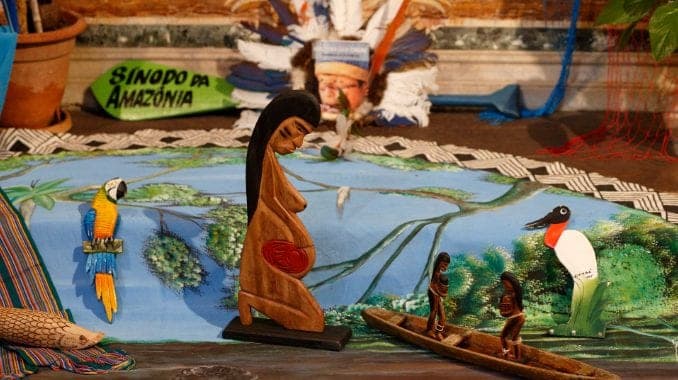ROME – About a decade ago, I was a fan of a TV series called “Lie to Me.” Tim Roth played Dr. Cal Lightman, a world-class expert in interpreting “microexpressions,” meaning small, fleeting signs on a person’s face, typically unnoticed by the naked eye, which reveal what he or she is truly thinking.
When it comes to Pope Francis and the Pachamama, however, one hardly needs a Cal Lightman to read someone’s facial reactions accurately.
In the wake of the Oct. 6-27 Synod of Bishops on the Amazon, in fact, I would submit this proposition: “Pachamama” has become the new insider Catholic version of “Who am I to judge?” meaning a single word or phrase which, immediately upon utterance in front of another Catholic, whatever comes across their face will tell you everything you need to know about where he or she stands.
Avid consumers of Catholic news hardly need me to explain what the Pachamama is, but in case someone has been out of touch for the last month, let me explain.
Actually, to quote “The Princess Bride”:
“No, there is too much. Let me sum up.”
The Pachamama is a female fertility figure, representing Mother Earth, venerated by peoples in the Andes and portions of the Amazon. In the context of the synod, it’s become the shorthand way of talking about several small figurines of a naked pregnant woman that made their initial appearance at an Oct. 4 indigenous prayer service in the Vatican gardens attended by Pope Francis, and that popped up several other times before going on display in Rome’s Church of Santa Maria in Traspontina near the Vatican.
From the beginning, they aroused intense controversy among traditionalist and conservative Catholics, who saw their presence at the Vatican – at the far end of opinion – as quasi-demonic symbols of pagan idolatry, or – somewhere closer to the middle – as expressions of an uncritical embrace of all things indigenous, without the “purification” which Pope emeritus Benedict XVI insists is the heart of Christianity’s interaction with cultures.
On Oct. 21, the figurines were stolen from the Church of Traspontina and tossed into the Tiber River, with one of the culprits, a faux cleric who uses the pseudonym “Father David” and who once claimed to be related to Benito Mussolini, insisting that he acted to defend the Church from “Satanism.”
Later, the figurines were retrieved by the Italian military police and returned to the Vatican, though they were not in evidence during Sunday’s closing Mass for the synod.
The synod may now be over, but debate lives on over what exactly the figurines represented. At first, some “more pro-Francis than Francis” types tried to insist they were depictions of the Visitation of Elizabeth by the Virgin Mary, while the “more Catholic than the pope” wing clamored that they were pagan idols.
Vatican spokesmen, meanwhile, asserted they were simply indigenous representations of life, devoid of any religious significance. (It was a fairly silly claim in hindsight, given that one learns in Anthropology 101 that indigenous cultures generally make no such distinction between the sacred and the profane, but that’s a point for another time.)
Some believe Francis himself settled the debate last Friday when, in apologizing for the theft of the images, he referred to the “Pachamama”. Even that, however, probably isn’t definitive, since by then “Pachamama” had become the staple word in the Italian media for the affair, and he may just have been engaging in the same shorthand as everyone else. In any event, he also clearly said the display of the images carried no “idolatrous intent.”
It’s probably telling that almost no one in the Western media made much of an effort to go ask the indigenous peoples themselves what the image represents.
In any event, here’s the comparison with “Who am I to judge?”
This one memorable phrase, spoken during the pope’s in-flight news conference on his way home from Brazil for World Youth Day in July 2013, came to sum up much of the spirit of Francis’s papacy: Non-dogmatic, non-judgmental, pastoral and generous, with an emphasis on meeting people where they are.
Depending on one’s attitudes, that’s either a breath of fresh air or a worryingly cavalier attitude towards the truth – and you’ll know instantly which of those poles a given person is closer to just by saying the words, and watching either the delighted grin or the vexed rolling of the eyes that ensues.
“Who am I to judge?” registered on the whole world’s radar screen, while, for now, the Pachamama remains insider Catholic baseball. For cognoscenti, however, it too captures a range of features of the Francis era: Its emphasis on the peripheries, its passion for dialogue and reconciliation with non-Christian cultures and religions, its “Third World” social and political agenda, and its willingness to set aside protocol and doctrinal and liturgical norms in order to make a point or deliver a message.
Again, those qualities inspire some and consternate others – and also again, to tell which is which, all you have to do is to say the magic word.
Whatever else the Synod on the Amazon may produce, therefore, it’s already bequeathed to history a second Francis shibboleth. That ought to save us all on word counts – and in the time of Twitter, which is where these fires tend to burn hottest, that’s undoubtedly something.
Crux is dedicated to smart, wired and independent reporting on the Vatican and worldwide Catholic Church. That kind of reporting doesn’t come cheap, and we need your support. You can help Crux by giving a small amount monthly, or with a onetime gift. Please remember, Crux is a for-profit organization, so contributions are not tax-deductible.















